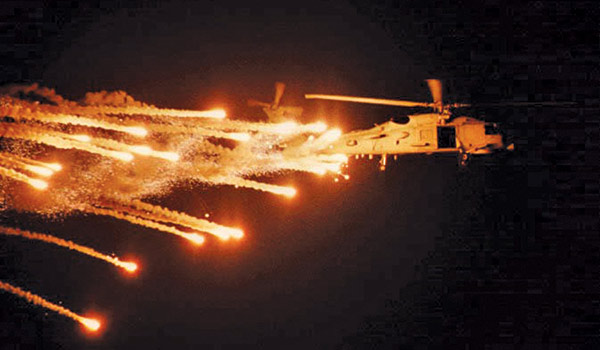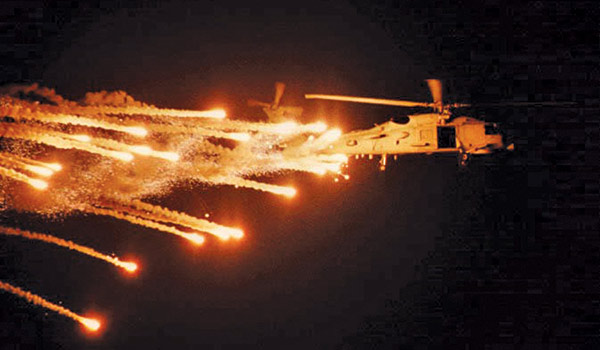
AMRDEC Tech Talk / By Mr. Frank McIngvale: Aircraft combat survivability relies on many factors such as threat avoidance, defensive measures, hardening of aircraft structures and components, redundant systems and repairable systems.
Put simply, the goal is avoid the threats that you can avoid (tactics, situational awareness), defeat the threats you cannot avoid (countermeasures), and survive the threats you cannot defeat (hardening, redundancy, reparability). Aircraft survivability has been a formal design discipline since the 1970s, but has gained increased attention in the past decade with the emergence of more advanced threats to our aircraft.

UH-60 Black Hawk dispensing countermeasures. / AMRDEC AED COURTESY PHOTO
AED Responsibilities
Army Regulation AR 70-75 states that combat survivability “is the capability of a system to avoid (susceptibility) or withstand (vulnerability) man-made hostile environments.” This applies both to equipment and to soldiers, as applicable for a particular system. An aspect of survivability that doesn’t seem to be explicitly covered in the AR 70-75 definition (although it can be easily inferred) is that we must consider the hazards that we create when integrating survivability solutions onto our aircraft. Aside from the typical limitations imposed on an airframe (weight, space, power), installing a piece of survivability gear can introduce hazardous items such as lasers and explosive ordnance such as flares. Within the Aviation Engineering Directorate (AED), we have several responsibilities in these areas. For one, we must ensure that any flares or chaff dispensed from the aircraft cannot endanger the aircraft structurally or through ingestion into the engines. A second primary concern is to ensure that any laser countermeasures added to the aircraft are either eye-safe or precautions have been taken to prevent injury to the crew when they are employed. This can be accomplished through the use of hard-stops on gimbaled systems or software programmable keep-out regions to prevent laser energy from entering the crew area. Failing either of these, goggles can be used to provide eye protection, but this is not the desired solution as it places additional burden on the crews.
Crew Workload
A related safety issue is that we must consider crew work load when designing survivability solutions. A piece of survivability equipment that requires a crewmember to constantly monitor a display for threat indications is going to be detrimental to the other duties that the crewmember is supposed to be performing, especially if those duties include flying the aircraft. Fortunately, over the past decade our systems have evolved into more autonomous suites that take action automatically without operator input. This has a two pronged effect of freeing the operator from having to monitor the screen as well as providing much faster response time than a human operator can typically achieve. The downside of automation is that a more complex system of safety interlocks is required to ensure that countermeasures are not inadvertently dispensed in a way that would create a hazardous situation, such as during ground operations. While there are some systems that have not yet been fully automated, things are moving generally in that direction.
Integrated Systems
Another interesting direction in survivability in recent years is that systems are becoming more integrated. In the past you would have multiple different systems, perhaps one would deal with infrared (“heat seeking”) missiles, one would deal with radar guided missiles and yet another would deal with laser guided missiles. And generally none of these would be smoothly integrated into the aircraft cockpit displays. Additionally, since none of the systems knew about the others, you could have issues of mutual interference and degraded performance as they stepped on each other trying to do their individual jobs. With the move towards more integrated solutions, we are seeing greater integration with cockpit displays (proving a more comprehensive situational awareness picture for the aircrews) and even vendors building systems that integrate multiple missile detecting functions at a low level on the same piece of hardware. In the coming years this seems likely to increase the ability to combine data from multiple sources and provide the optimal defensive response in any scenario.
In summary, the continual evolution of threats to our aircraft means that we must continually update our defensive systems to successfully protect our aircraft. Modern reprogrammable systems allow shorter timelines, yet the design, analysis and testing required remains a complex task. In the end, the payoff is greater protection for our crews from hostile threats while they perform their duties.
Mr. Frank McIngvale is an electronics engineer with the Mission Equipment Division of the Aviation Engineering Directorate of the U.S. Army Aviation and Missile Research, Development, and Engineering Center located at Redstone Arsenal, AL.










